How Much More Does Crossing The Holland Tunnel Cost Today?

You do not need the ghost of Andy Rooney to remind you that, if traveling by automobile is a big chocolate cake of frustration, then the tolls that may be collected from you are the frosting. These tolls are such an annoyance (if not an outright burden) that they’re avoided as a topic by even the most amateur of our stand-up comics. And of the costs that are difficult to avoid in the day-to-day, these are definitely increasing, right? Increases mount, and what was once an afterthought, tossing some change into a basket, is now an expense to be reckoned with.
But even if we all agree that, yes, nationwide, tolls are skyrocketing, does this necessarily mean that these tolls are actually more than what’s been charged on an historical basis, when the old tolls are adjusted into modern dollars? In other words, are toll increases actually increases, or just adjustments keeping up with inflation? With apologies to you city dwellers (like me!) who judge this to be a topic that could easily be obviated by taking public transportation, let’s see what transportation tolls have done, and, to narrow the focus, let’s look specifically at the Holland Tunnel.
***
Why the Holland Tunnel? Well, for one, it’s the first of its kind. Connecting Jersey City with Lower Manhattan, the Holland Tunnel runs about a mile and a half underneath the Hudson River, and carries around twenty million vehicles a year in each direction. And it’s not just a daily commute boondoggle — it’s also an historic feat of engineering, recognized by the U.S. Department of the Interior as a National Historic Landmark and by the American Society of Civil and Mechanical Engineers as a National Historic Civil and Mechanical Engineering landmarks — honors that are not handed out like Rite Aid circulars.
A hundred years ago, the men responsible for the civic planning of the greater New York metropolitan area were coming to realize that some of the features that made the location a good one for a large city were also prohibitive for growth. New York City is located where the Hudson dumps out into the Atlantic Ocean — extraordinarily useful for placing a city, as water was historically advantageous for trade. But the city is not just a good place for ports, it’s an archipelago, with only two out of five boroughs contiguous. So even as trade flowed in, all that water made getting around, between the boroughs somewhat of a hassle, especially as population grew and more and more goods and people needed to cross the rivers. At the time, none of the Hudson bridges or tunnels existed, so crossing was accomplished primarily by ferries, and was aided by two railway tunnels that were built (in 1908 and 1909) under the Hudson. Add in newly created vehicular traffic, as people began to purchase the new-fangled horseless carriages, and it was obvious to those involved that the Hudson needed to be forded.
Civic planning on this scale is never easy. In this case, two different states were involved, and New York and New Jersey each formed commissions to be headed by engineers to come up with a solution. They settled on a tunnel as the first effort, and selected the straits between Jersey City and Canal Street due to the presence of railyards on the one side and a warehouse district on the other. There was of course all manners of political and parochial bickering between the states, patronage scandals, power grabs and kickback schemes (some things never change), but construction began in 1920, with the states splitting the expense. (For more detail on colorful political obstacles surmounted, go grab Highway Under The Hudson: A History of the Holland Tunnel by Robert W. Jackson, which is exactly what its title says.)
How does one build a tunnel underwater? That’s certainly a question that vexed me as a little kid. In the case of the Holland Tunnel, they started on either shore, sunk a big hole and then bored through the earth by pushing what they called a shield, which was the size of the circumference of the tunnel, inch by inch forward. After each incremental progress, the dirt and muck would be carted out, and a cast-iron sheath would be bolted into place behind the shield. So if anyone asks, yes, the Holland Tunnel is made of cast iron.
It was (as it would seem) a difficult operation. Although other underwater tunnels had already been built, leaving an available population of engineers and laborers with experience at this, it was still a dangerous occupation, as the sandhogs were working in chambers pressurized with compressed air to keep seeping water out. This is where the bends became understood, and not through deep sea diving, as workers who returned to normal air pressure conditions too quickly would come down with depressurization sickness — nitrogen bubbles in the bloodstream that cause various sorts of pains and discomforts, up to and including death. Thirteen sandhogs lost their lives in the building of the tunnel (and those are just the deaths that were reported).

The tunnel also took the life of the man who conquered the biggest problem facing the tunnel. His name was Clifford M. Holland, and he was the engineer selected to oversee the entire project, mostly for his experience in overseeing subaqueous subway tunnels under the East River. But while subway and train tunnels carried traffic that was powered electrically or by steam engines, cars are powered by internal combustion engines, which manufactures the by-product of carbon dioxide as exhaust, which is lethal in enclosed spaces (like garages, or global climates). They could build a tunnel under water, but they had to figure out how to dissipate the noxious fumes, lest the tunnel becomes one big suicide machine.
Holland solved it with ventilation. The tunnels (there are two of them, one in each direction) are circular, but the roadway and the ceiling are flat. The empty spaces under the roadway and above the roof are basically giant ventilation ducts, one pushing in fresh air and the other sucking out bad. On each shore of the river, there is a giant building (each with an Art Deco façade, so easy on the eyes) which is the power plant for the ventilation. Turns out it worked, although Holland didn’t make it to see, as he succumbed to the pressure of the project and poor health in 1924. But they did name the tunnel after him, so, no, the name of the Holland Tunnel is not a nod to the Dutch that first settled the area, but rather a posthumous honor bestowed, if not a nearly-anonymous one. As Ian Frazier wrote in a New Yorker essay in 1990 (sub. required), “At the time the tunnel was named for him, editorial writers worried that people would think that the name had something to do with Holland the country. In later years, that happened.” (Going off in search of people who can tell him how the tunnel got its name, Frazier eventually gets a correct answer: From a tourist from Japan.)
In 1927, the Holland Tunnel opened, an occasion that was somewhat of a holiday for New Yorkers (and the New Yorkers living in Jersey), with speeches and parades and fireworks. And on the first day of operation, over fifty thousand vehicles drove the tunnel, each paying fifty cents for the honor (which, by the way, converts into $6.46 in 2011 dollars).
***
In case you have never traversed the Hudson River via the Holland Tunnel, here’s a brief description. There are two tubes, with two lanes in each tube. Ten years or so ago they painted LANE IN STAY at beginning of each tube, as there is no passing. A narrow walkway runs down the length of the right side, but there’s nothing in the way of a break-down lane. The walls and roof are tiled, like a public bathroom wall, and here and there are patches where the tiles have fallen and not yet been replaced. The tiles are differing shades of beige, as if the wallpaper of the sitting room of a fifty-year smoker. It’s like driving down a corridor in an office park somewhere, over an institutional stain-resistant carpet, lit by flickering fluorescents. Not that it’s unpleasant. The traffic can be unpleasant, of course, but YOU’RE DRIVING UNDERWATER, which is a bit of a mind-blower the first time. It is not without its charm, but it is showing its age.

It’s apt that the Holland Tunnel is so unchanged in many ways, because, for nearly 50 years, the tolls were unchanged as well, at $.50 a pop. Technically, they increased to one dollar in 1970, but that’s a little misleading, as 1970 was when tolls were no longer charged in each direction. The Port Authority of New York and New Jersey, the agency tasked with operating and maintaining the Holland Tunnel since 1930 (and responsible for other Hudson River crossings, the PATH rail system, five area airports, bus terminals, the World Trade Center and the waterfront ports of the greater metro area), realized that by collecting tolls in only one direction, the costs of toll collection could be halved — and congestion eased in the non-toll collecting direction. So the toll went up to a buck, coming in from New Jersey, because you were basically (and still are) pre-paying for a round trip. The same thing happened with the Golden Gate Bridge in San Francisco in 1968, when the each-way toll of $.25 became a one-way toll of $.50.
Incidentally, toll hikes were never contemplated in the original plan to build the Holland Tunnel, as tolls were to be rescinded after the initial costs of building the tunnel were recouped. But by the time this recoupment was close, PANYNJ had taken over the tunnel, and needed further financing for the construction of all the other Hudson River Crossings named after engineers (Goethals, Outerbridge) or presidents (Lincoln, Washington). PANYNJ is entirely non-profit, as it runs according to an interstate compact negotiated between New York and New Jersey. For PANYNJ to raise capital, it issues bonds, approved by the two states, which are backed by PANYNJ’s toll and rental income. Long story short, when PANYNJ needs financing, they raise tolls.
Of course toll hikes are controversial events. Beyond the complaints of the nine-to-fivers and the red-faced op-eds, the American Automobile Association has a habit of taking PANYNJ to court over the hikes. The first time was in the late ’70s, after the first hike in decades in 1975, from $1 to $1.50 ($6.27 adjusted); the case, alleging that the increase was unreasonable under an old federal statute, as was a second suit in 1987, and a third over the most recent increase which took effect last year.
But by the ’80s and after, the increases come at a pretty steady clip, as listed below. Keep in mind that these are all cash tolls paid, without discount. The PANYNJ has diligently offered numerous mechanisms to alleviate the burden on daily commuters — discounted ticket books, high-occupancy vehicle discounts, off-peak pricing and the EZ-PASS transponders that are pretty much ubiquitous by now, which of course were and are taken advantage of by commuters, but for my purposes, we’re using peak, non-discounted, wait-in-the-long-line tolls, because for the first decades of the tunnel, that’s what everyone paid.
1975 -1980 $1.50
1980 -1987 $2
1987–1991 $3
1991–2001 $4
2001–2008 $6
2008–2011 $8
2011 — NOW $12
It may be hard to believe that PANYNJ is a nonprofit, given the millions of dollars of tolls collected in the Holland Tunnel alone. The administration of PANYNJ is frequently a topic of debate, as, while it has to spend a lot of money to keep the traffic moving, it’s also taking in a lot of money at the same time, and public administration of funds is something people have a hard time agreeing on. But give yourself some quiet time with the most recent available budget [.pdf], and you’ll see that the revenues from bridges, tunnels and terminals is a little less than a billion dollars, with an overall budget over seven billion.
The problems of how we get stuff from one place to another, whether that stuff is goods or produce or our own personal selves, and who pays for it, are enormous ones, and the surfaces of which are hardly being scratched in this piece. But the upkeep of PANYNJ’s massive network of infrastructure doesn’t pay for itself, any more than the building of it did. Without taking sides in any of the myriad chair-fights over infrastructure, if the Holland Tunnel tolls are a rip-off, they are rip-offs borne of necessity.
***
But are the Holland Tunnel tolls a rip-off, perceived or not? Let’s look.
Below is the price-adjusted list, in 2011 dollars. All tolls are for round-trips (so pre-1970 tolls are doubled), and without the discounts available at the time, and an arbitrary ten-year gap is applied to the fifty years in which the toll did not increase:
1927: $12.92
1937: $15.62
1947: $10.08
1957: $8.00
1967: $6.74
1975: $6.27
1980: $5.46
1987: $5.94
1991: $6.61
2001: $6.69
2008: $8.36
2011: $12
That is a trend that we’ve not seen before: a giant U. Holland Tunnel fares started out as pretty expensive, and then (other than a bump during the Depression), declined slowly, even after the toll increases began in the ’70s, and then started climbing back up to the high rates of the early days. It’s a pretty telling snapshot of the cost of infrastructure in the new century.
Compared to tolls at some of the other municipally run fee-based underwater tunnels in the U.S. ($4 each way for the Detroit-Windsor Tunnel, $3.50 one-way for the tunnels underneath Boston Harbor, $3 each way for the two tunnels underneath Baltimore Harbor), the Holland Tunnel does come off as comparatively expensive.
I’m confident that the job of running PANYNJ, or any of the other municipal authorities trying to keep bridges from falling and roads from disintegrating, is not a job that I’d volunteer for anytime soon. At the same time, even considering the hours I’ve spent in traffic and who-knows-how-much money I’ve spent on tolls, the absence of the Holland Tunnel, and the Hudson tunnels and bridges that followed it, is hard to imagine living without it. With this city, it seems about right that you have to pay to enter but anytime you want to leave it’s on the house.
Previously: Chinese Food, Books, Barbies, Televisions and Steak Dinners
Brent Cox is all over the Internet. Top photo by Kmf164; middle and bottom photos, both taken in 1985, courtesy of U.S. Library of Congress, via Wikimedia Commons.
